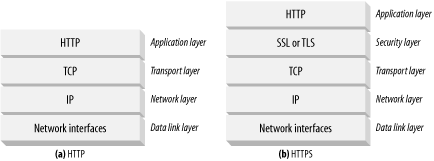HTTPS: The Details
HTTPS is the most popular secure version of HTTP. It is widely implemented and available in all major commercial browsers and servers. HTTPS combines the HTTP protocol with a powerful set of symmetric, asymmetric, and certificate-based cryptographic techniques, making HTTPS very secure but also very flexible and easy to administer across the anarchy of the decentralized, global Internet.
HTTPS has accelerated the growth of Internet applications and has been a major force in the rapid growth of web-based electronic commerce. HTTPS also has been critical in the wide-area, secure administration of distributed web applications.
HTTPS Overview
HTTPS is just HTTP sent over a secure transport layer. Instead of sending HTTP messages unencrypted to TCP and across the world-wide Internet (Figure 14-13a), HTTPS sends the HTTP messages first to a security layer that encrypts them before sending them to TCP (Figure 14-13b).

Figure 14-13. HTTP transport-level security
Today, the HTTP security layer is implemented by SSL and its modern replacement, TLS. We follow the common practice of using the term “SSL” to mean either SSL or TLS.
HTTPS Schemes
Today, secure HTTP is optional. Thus, when making a request to a web server, we need a way to tell the web server to perform the secure protocol version of HTTP. This is done in the scheme of the URL.
In normal, nonsecure HTTP, the scheme ...
Get HTTP: The Definitive Guide now with the O’Reilly learning platform.
O’Reilly members experience books, live events, courses curated by job role, and more from O’Reilly and nearly 200 top publishers.

